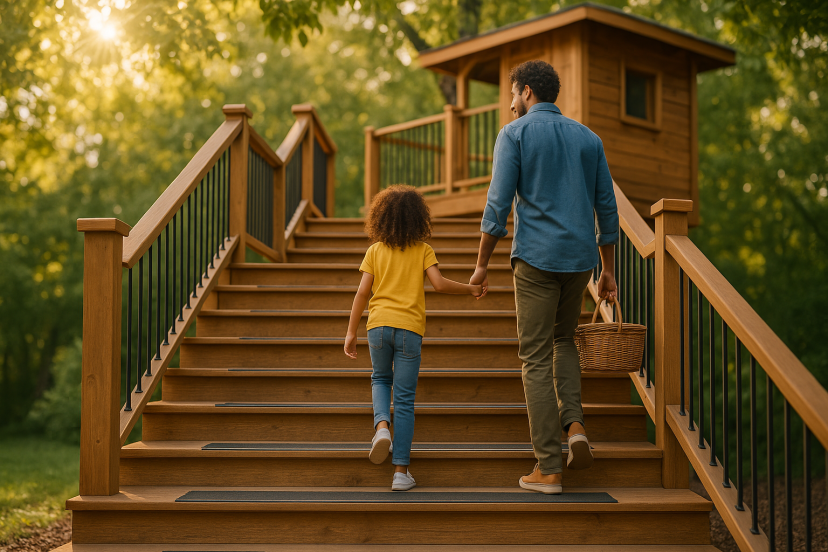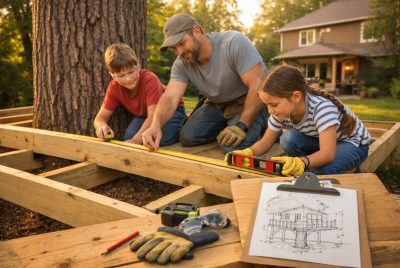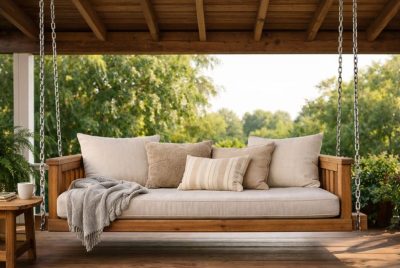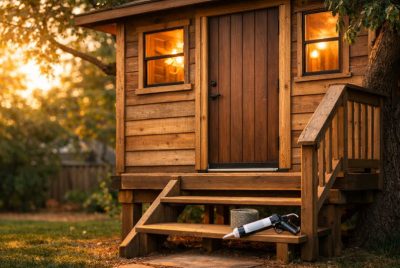5 Creative Treehouse Stairs and Ladder Ideas for Easy Access
We may earn a commission for purchases made using our links. Please see our disclosure to learn more.
You’ve got the treehouse. Now comes the surprisingly personal part: how you’ll get up there, safely and comfortably. If you’ve ever carried a tray of snacks in one hand while steadying a wobbly ladder with the other, you know access can make or break the magic. In this friendly guide, we’ll explore five creative, real-world ways to build or buy treehouse stairs—from compact spiral stairs to playful climbing-wall steps—plus safety tips, smart materials, and Amazon picks to make the project easier. We’ll keep things practical, research-backed, and budget-aware, and yes, we’ll talk style, too. By the end, you’ll feel confident choosing treehouse stairs that fit your space, your people, and your plans.
How to Choose Treehouse Stairs for Your Space
Before you fall in love with a design, take a quick inventory:
- Height & approach: Total rise (ground to floor) and where people naturally walk from.
- Footprint: How much horizontal space can you give stairs or a ladder?
- Users: Kids? Teens? Adults hauling gear? Pets?
- Vibe: Rustic wood, modern steel, or something whimsical?
- Climate: Rain, humidity, snow, and leaf litter all affect traction and longevity.
- DIY vs. kit: Are you building from scratch or assembling a kit?
Mini-reflection: What’s one “must” for your access—space saving, easy for kids, or haul-friendly for adults?
Safety First: Heights, Handrails, and Codes You Should Know
Even for backyard projects, it’s wise to design with well-understood safety dimensions in mind (always confirm local rules):
- Standard exterior stair basics (IRC): Many jurisdictions that use the International Residential Code set maximum riser height around 7¾ in. and minimum tread depth around 10 in.—aiming for consistent steps all the way up for predictable footing.
- Spiral stairs specifics (IRC): Spiral treads often have different minimums—commonly ≥6¾ in. depth at the walkline; check your local adoption.
- Ladder rung spacing (OSHA reference): For fixed ladders, 10–14 in. rung spacing is a widely cited safety range.
- Why it matters: Falls are a leading cause of injuries on play structures and on ladders in general; design choices that reduce slips and missteps help.
Pro tip: Add non-slip treads, handrails at graspable height, and landing space at the top so first steps onto the platform feel calm, not precarious. AWC’s deck guide offers helpful stair and landing diagrams you can adapt for treehouse platforms.
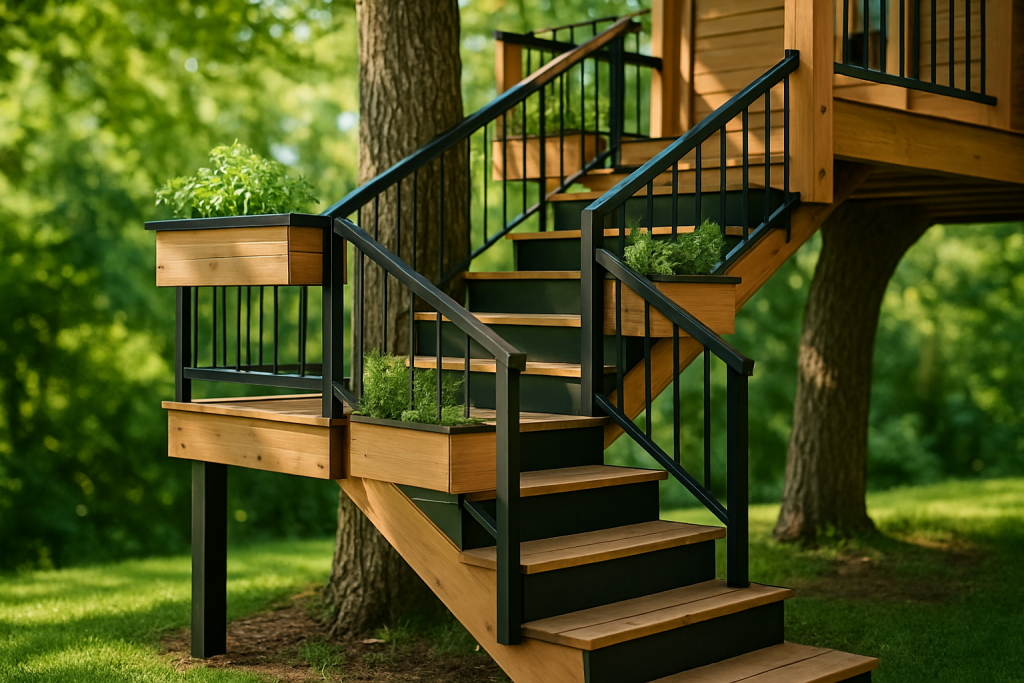
Idea #1: Compact Spiral Staircase (Space-Saver with Style)
When space is tight but you want a “wow” factor, spirals shine.
Best for
- Small footprints, limited approach areas, and adults/older kids comfortable with narrower steps.
Why people love it
- Minimal footprint: A tidy circle instead of a long run of steps.
- Architectural vibe: Looks custom without gobbling yard space.
Considerations
- Tread shape: Narrow near the center—teach kids to step at the walkline where treads are deeper.
- Handrail quality: A sturdy continuous rail is non-negotiable.
Build & buy notes
- Pre-engineered spiral stair kits (steel or aluminum) assemble like big Erector sets. Powder-coated finishes resist weather.
Idea #2: Alternating-Tread “Ship” Stairs (Steep but Climbable)
Alternating-tread stairs (sometimes called “ship ladders”) trade shallow depth for a steep, compact climb.
Best for
- Adults and older teens, tight spaces, and gear-light use.
Why people love it
- Space saver: Roughly half the run of standard stairs.
- Surprising comfort: Alternating pads fit your feet like a rhythm.
Considerations
- Not ideal for toddlers. Add grippy nosings, bright contrast strips, and dual handrails for confidence.
Idea #3: Modular Stringer Stairs (DIY-Friendly & Sturdy)
Use pre-cut stringers or adjustable metal stringers with deck-style treads.
Best for
- Family use, hauling snacks or tools, all-weather durability.
Why people love it
- Familiar feel: Looks and climbs like a deck stair.
- Flexible: Easy to add landings, turns, or switchbacks.
Considerations
- Keep risers consistent; aim near ≤7¾ in. rise and ≥10 in. tread depth to match typical residential expectations (confirm locally).
Idea #4: Hybrid Ladder with Safety Rail (Secure Vertical Access)
A fixed ladder with rungs at 10–14 inches apart and dual side rails can be safe, compact, and budget-friendly if you add fall-friendly surfacing below and a guarded opening at the top.
Best for
- Very limited footprints, tall trees, and confident climbers.
Upgrades that help
- Offset handholds at the top so climbers transition naturally onto the platform.
- Magnetic or keyed gate at the hatch to keep little ones from climbing unsupervised.
Idea #5: Climbing-Wall “Stairs” (Playful Access That Doubles as Activity)
Turn ascent into play with low-angle climbing panels and oversized holds arranged like wide steps.
Best for
- School-age kids with supervision, active families, playful aesthetics.
Build tips
- Keep the wall at a gentle angle and pair it with a parallel handrail or adjacent easy ladder.
- Use big, grippy holds—think “stairs you can grab.”
Safety backdrop
- Remember, falls are a common play injury—so add impact-absorbing surfacing (mulch, chips, rubber) under access zones and keep openings free from head-entrapment gaps.
Age-Appropriate Options: Kids, Teens, and Adults
- Little kids (4–5): Wide steps, shallow rises, generous handholds; avoid steep alternating treads. Keep access heights modest and spacing consistent.
- School-age (6–12): Can enjoy moderate slopes and playful elements; pair fun with real handrails and non-slip surfaces.
- Teens & adults: Comfortable with steeper options (spiral, ship-ladder) but still benefit from lighting, good rails, and grippy nosings.
Weatherproofing and Material Choices (Wood, Metal, Composites)
- Pressure-treated lumber: Classic, budget-friendly; seal annually in wet climates.
- Cedar or teak: Beautiful, naturally rot-resistant; higher upfront cost, lower fuss.
- Powder-coated steel/aluminum: Durable, precise; match modern treehouse vibes.
- Composite treads: Great traction and low maintenance on deck-style stairs.
Analogy: Think of materials like hiking footwear—leather (classic), trail runners (lightweight composites), or mountaineering boots (powder-coated steel). Pick what fits your terrain and style.
Add-Ons That Boost Safety and Confidence
- Handrails you can truly grasp (round or eased edges).
- Anti-slip treads and nosing strips where leaves or rain collect.
- Low-voltage stair lights so dusk climbs feel cozy, not risky.
- Top landing with a gate or baluster spacing that avoids head entrapment.
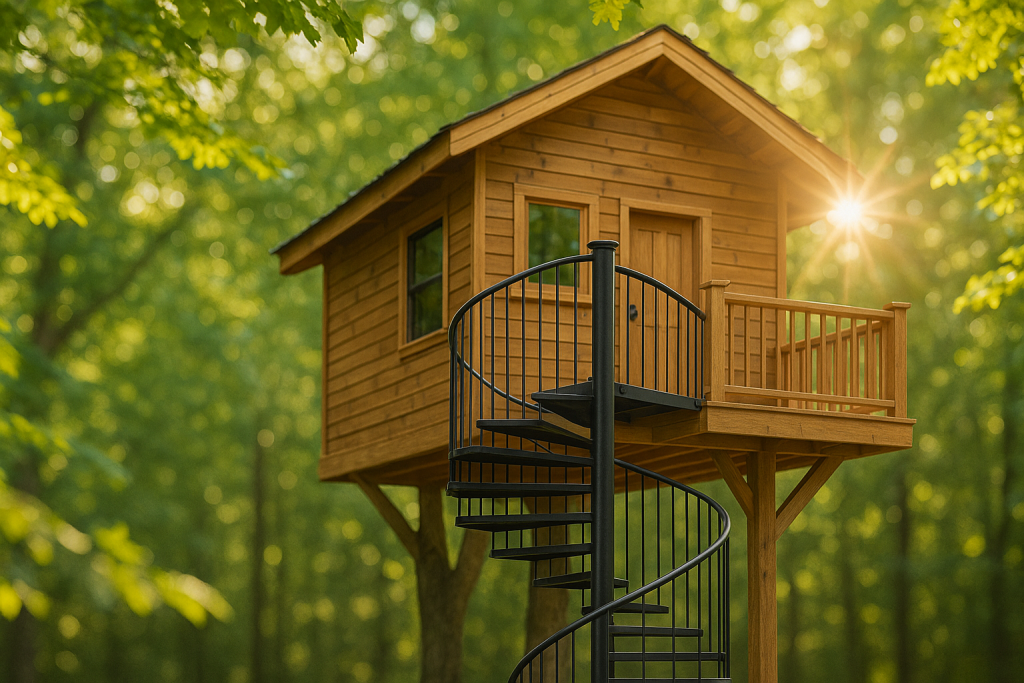
Step-by-Step Planning Checklist (Mini Challenge)
- Measure total rise and sketch your footprint.
- Choose your access type (spiral, ship, deck-style, ladder, or hybrid).
- Decide handrail style and landing configuration.
- Pick materials for climate + maintenance level.
- Add traction & lighting to your parts list.
- Price out DIY vs. kit.
- Do a walkthrough: imagine carrying a pillow, a cooler, a sleepy kid—does your design still feel safe and kind?
Common Mistakes to Avoid (and How to Fix Them)
- Inconsistent risers: Causes trips. Fix: Re-cut or shim to keep rises consistent.
- Too-steep for the users: If little kids are primary users, reconsider alternating treads; add a gentler route.
- Slippery finishes: Sealers that get glassy when wet—swap for textured coatings or add grip tape.
- No landing at the top: Create a calm step-off with railings around the opening.
Amazon Picks: Ready-to-Buy Stair & Ladder Solutions
(Note: Always verify measurements and local code requirements for your location.)
1) Spiral Stair Kit (Outdoor Steel, 5–10 ft rise options)
Why it works: Minimal footprint, durable powder coat, continuous handrail.
Great for: Tight yards, modern or industrial look.
Consider: Narrow inner steps—coach young climbers to step at the walkline.
2) Alternating-Tread Stair (Adjustable Metal Stringers)
Why it works: Ship-style alternating pads for compact climbs; solid side rails.
Great for: Adults/teens, small footprints.
Consider: Not toddler-friendly; add lighting and high-contrast nosings.
3) Adjustable Exterior Stair Stringers (Deck-Style)
Why it works: Lets you dial in rise/run; pairs with composite or timber treads.
Great for: All-ages access, hauling gear, familiar feel.
Consider: Confirm tread depth and riser height with local code.
4) Fixed Outdoor Ladder with Handrails
Why it works: Compact, sturdy, 10–14 in. rung spacing aligns with widely referenced safety ranges.
Great for: Minimal footprints, utility access.
Consider: Add a top gate and cushioned ground surfacing.
5) Kids’ Climbing Holds Kit (Outdoor, Bolt-On)
Why it works: Oversized textured holds turn a gentle slope into a playful ascent.
Great for: School-age kids with supervision.
Consider: Keep angles friendly and combine with a parallel easy ladder.
6) Outdoor Stair Handrail Kit (Cut-to-Fit)
Why it works: Quick, sturdy handholds boost confidence on any stair type.
Great for: Retrofitting existing stairs or ladders.
Consider: Mount into solid framing; test the grab feel for small hands.
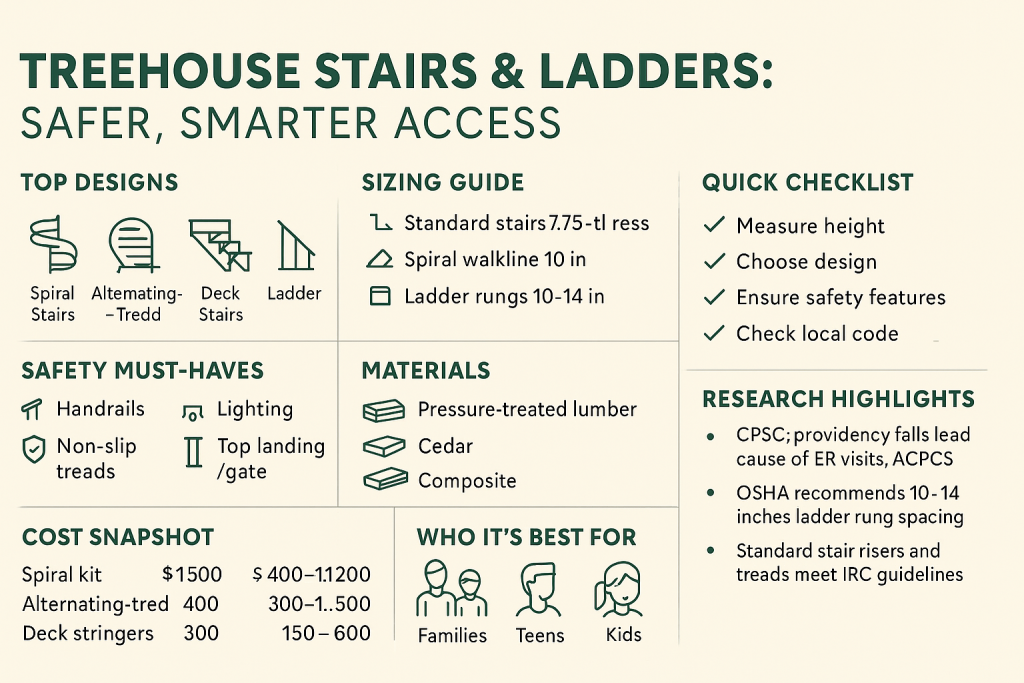
Quick Comparison
| Product Type | Space Needed | Best For | Standout Strength | Watch-outs |
| Spiral Stair Kit | Very small | Style + tight sites | Minimal footprint, continuous rail | Narrow inner treads |
| Alternating-Tread Stair | Small | Adults/teens | Compact, rhythmic climb | Not suitable for toddlers |
| Adjustable Deck Stringers | Medium | Families + gear | Familiar, stable steps | Needs careful layout of rise/run |
| Fixed Ladder w/ Rails | Very small | Utility access | Simple, budget-friendly | Vertical climb; gate strongly advised |
| Climbing Holds Kit | Variable | Playful access | Doubles as activity | Gentle angle + supervision |
| Handrail Kit | N/A | Any stair type | Confidence and safety | Must mount into structure |
Research-Backed: Why Safer Access Matters
- Play structures & falls: The CPSC’s Playground Safety Handbook highlights falls as a leading injury type on play equipment, underscoring the value of guarded openings, appropriate spacing, and impact-absorbing surfacing around access points.
- Ladders & injuries: NIOSH (CDC) reports thousands of ladder-related injuries and fatalities annually, reinforcing the importance of correct ladder selection and setup—even for home projects like treehouse access.
- Dimensions that work: The IRC provides widely referenced step dimensions (riser/tread) for predictable footing; spiral stairs have their own tread rules at the walkline to balance fit with safety.
- Rung spacing: OSHA standards specify 10–14 in. spacing for fixed ladder rungs to support natural climbing cadence.
FAQs
How safe are spiral stairs for children using a treehouse?
They can be—with a sturdy handrail, good traction, and coaching to step at the walkline where treads are deeper. Consider an alternate, gentler access for toddlers.
What’s the safest stair rise and tread depth to aim for?
Many places using the IRC target ≤7¾ in. rise and ≥10 in. tread depth for comfortable, predictable steps. Always confirm local code.
How far apart should ladder rungs be?
A commonly referenced standard for fixed ladders is 10–14 inches between rungs center-to-center.
Do I need a landing at the top?
A landing makes step-offs calmer and safer, especially when carrying items. Include guardrails around openings.
What surfacing should I put under the access?
Impact-absorbing surfacing—like wood chips, mulch, or rubber—helps reduce injury severity from falls around climb zones.
Curious about compact living ideas that pair well with backyard builds? Explore this side-by-side look at space-efficient homes in our 20-foot container home vs. tiny house guide for smart layout inspiration.
Conclusion
Your access sets the tone for every treehouse moment—first steps up, last glide down, and all the snack runs in between. Whether you go spiral for a sculptural statement, alternating-tread to save space, deck-style for everyday comfort, a compact ladder with rails, or a playful climbing wall, the best choice is the one that fits your footprint, family, climate, and confidence. Add grippy treads, real handrails, warm lighting, and a calm top landing. Measure twice, design with safety in mind, and you’ll build a path that feels as welcoming as the treehouse itself.

